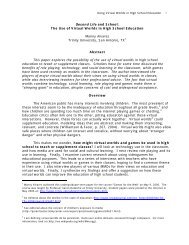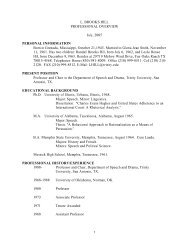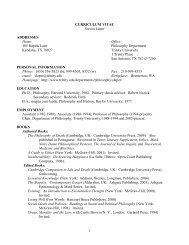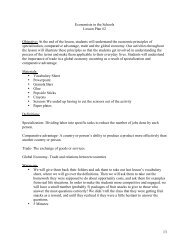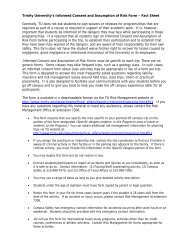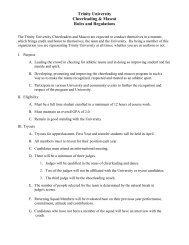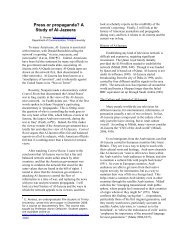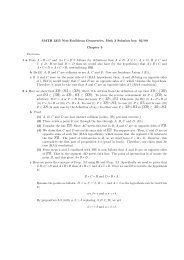Dimensions of Sacred Space in Japanese ... - Trinity University
Dimensions of Sacred Space in Japanese ... - Trinity University
Dimensions of Sacred Space in Japanese ... - Trinity University
Create successful ePaper yourself
Turn your PDF publications into a flip-book with our unique Google optimized e-Paper software.
Intercultural Communication Studies VI: 2 1996 Randall Nadeau<br />
Spatial hierophanies "<strong>in</strong>terrupt" space and make it non-homogeneous, and the dist<strong>in</strong>ctive realms <strong>of</strong> sacred and<br />
pr<strong>of</strong>ane space are divided by boundaries and doorways that allow one to pass from one "mode <strong>of</strong> be<strong>in</strong>g" <strong>in</strong>to<br />
the other.<br />
The threshold that separates the two spaces ... <strong>in</strong>dicates the distance between two modes <strong>of</strong> be<strong>in</strong>g,<br />
the pr<strong>of</strong>ane and the religious. The threshold is the limit, the boundary, the frontier that dist<strong>in</strong>guishes<br />
and opposes two worlds -- and at the same time the paradoxical place where those worlds<br />
communicate, where passage from the pr<strong>of</strong>ane to the sacred world becomes possible. i<br />
Sh<strong>in</strong>to, with its emphasis on defilement and purification, associates pr<strong>of</strong>ane space with pollution and<br />
evil, and sacred space with purity and brightness. ii The dichotomy between parallel clusters <strong>of</strong> concepts --<br />
<strong>in</strong>ner/sacred/pure and outer/pr<strong>of</strong>ane/polluted -- is def<strong>in</strong>itive <strong>of</strong> <strong>Japanese</strong> cosmology and the <strong>Japanese</strong> character,<br />
cutt<strong>in</strong>g across the boundaries <strong>of</strong> nature, nation, community, home, and person. For each <strong>of</strong> these concentric<br />
realms, the dist<strong>in</strong>ction between two modes <strong>of</strong> be<strong>in</strong>g is clear, marked by the torii as well as by other boundary<br />
symbols.<br />
The dist<strong>in</strong>ction between sacred space and pr<strong>of</strong>ane space, between the pure "<strong>in</strong>ner" and the impure<br />
"outer," is not limited to the boundaries <strong>of</strong> Sh<strong>in</strong>to shr<strong>in</strong>es. iii The "<strong>in</strong>ner" is the world <strong>of</strong> nature, <strong>in</strong> opposition<br />
to the cosmos and heavens. It is the nation, <strong>in</strong> opposition to what lies beyond the seas. It is the native place<br />
(rural village or city ward), <strong>in</strong> opposition to outside communities. It is the home, <strong>in</strong> opposition to the homes <strong>of</strong><br />
strangers. And it is the heart or private self, <strong>in</strong> opposition to other persons and one's own public self. All <strong>of</strong><br />
these <strong>in</strong>ner, sacred realms are marked by symbolic gates -- whether material or immaterial -- which serve to<br />
dist<strong>in</strong>guish sacred and pr<strong>of</strong>ane realities or ways <strong>of</strong> be<strong>in</strong>g.<br />
The most basic dist<strong>in</strong>ction is that between the natural world (the space <strong>of</strong> productive activity) and the<br />
cosmos or heavens, which are outside the realm <strong>of</strong> manipulation and are thereby threaten<strong>in</strong>g and<br />
unpredictable. Kami reside <strong>in</strong> both realms, but only the kami identified by symbols <strong>of</strong> sacred orientation and<br />
physical separation (shr<strong>in</strong>es, gates, etc.) are designated as part <strong>of</strong> a pure "<strong>in</strong>ner" realm. Shr<strong>in</strong>es to the kami <strong>of</strong><br />
the cosmos/heavens such as Amaterasu and Susano-o serve to "domesticate" these deities and br<strong>in</strong>g them <strong>in</strong>to<br />
the "<strong>in</strong>ner" world.<br />
The heavens represent one "outside" world. The space beyond the seas represents another. The islands<br />
<strong>of</strong> Japan are sanctified by the kami <strong>of</strong> nature and by the creator-kami <strong>of</strong> the mythic chronicles (Kojiki and<br />
Nihongi). The dramatic torii at Miyajima, as well as similar <strong>of</strong>f-shore gates symbolically surround<strong>in</strong>g the<br />
<strong>Japanese</strong> islands, show that Japan itself is "<strong>in</strong>ner" and sacred, a closed circle isolated from the threaten<strong>in</strong>g and<br />
impure space beyond the seas. At the center <strong>of</strong> the circle stands Mt. Fuji, div<strong>in</strong>e symbol and axis mundi <strong>of</strong> the<br />
sanctified world. iv And with<strong>in</strong> this world are the protective kami <strong>of</strong> natural features, <strong>in</strong>habit<strong>in</strong>g the space <strong>of</strong><br />
the productive field. The kami <strong>of</strong> the natural world are sanctify<strong>in</strong>g agents for the nation as a whole,<br />
exorcis<strong>in</strong>g evil and purify<strong>in</strong>g the land by their presence.<br />
On a microcosmic level, the dist<strong>in</strong>ction between <strong>in</strong>ner and outer applies to the <strong>in</strong>dividual community,<br />
home, and person, all demarcated by "gates" or thresholds that serve as boundaries between the sacred and the<br />
pr<strong>of</strong>ane. These may not be physical torii-style gates, but the division between <strong>in</strong>ner and outer is marked<br />
symbolically.<br />
The village or neighborhood community is bounded by small shr<strong>in</strong>es <strong>in</strong>dicat<strong>in</strong>g the protective presence<br />
<strong>of</strong> local kami, isolat<strong>in</strong>g it from the outside. These <strong>in</strong>clude the kami <strong>of</strong> fields, ponds, streams, and bridges, all<br />
marked by their shr<strong>in</strong>es (<strong>of</strong>ten simple structures only a few feet or even a few <strong>in</strong>ches <strong>in</strong> height). Most<br />
significant are the shr<strong>in</strong>es <strong>of</strong> the dôsoj<strong>in</strong>, the boundary gods protect<strong>in</strong>g travelers and oversee<strong>in</strong>g the<br />
community as a unified whole.<br />
A similar function is performed by the fence or wall surround<strong>in</strong>g the <strong>in</strong>dividual residence, which, <strong>in</strong> the<br />
rural household, is sanctified by the kami <strong>of</strong> the traditional farm build<strong>in</strong>gs: storehouse, shed, barn, and latr<strong>in</strong>e.<br />
Walls and fences are obvious boundary markers separat<strong>in</strong>g the pure <strong>in</strong>ner and impure outer, and are a<br />
common architectural feature <strong>of</strong> a variety <strong>of</strong> structures. The effect is heightened when fences are encased<br />
with<strong>in</strong> fences, <strong>in</strong> concentric patterns <strong>of</strong> enclosure, as at the Grand Shr<strong>in</strong>e at Ise, its space so sacred that access<br />
is forbidden to ord<strong>in</strong>ary persons.<br />
The <strong>in</strong>ner purity <strong>of</strong> the household itself is protected by the vestibule or entranceway (genkan) where<br />
shoes are removed, guests are greeted, and rites <strong>of</strong> purification are performed when the house is consecrated<br />
110 110






